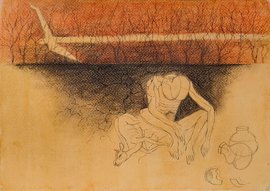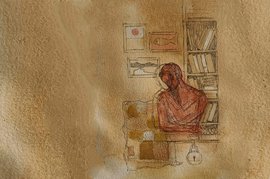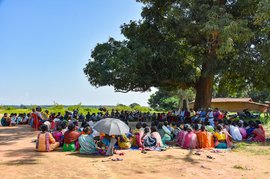A sacred hillock on the outskirts of Anjan village is dotted with both saffron and white flags. The white flags belong to the Sarna followers of nature-worshipping Adivasi communities – in this case Oraon Adivasis, while the saffron flags belong to Hindus who built a Hanuman temple in 1985, at the top of the hill in Gumla district of Jharkhand. They claim that it is the birthplace of the Hindu god.
Two large banners on the bamboo gate name two committees. The Gumla Van Prabandhan Mandal run jointly by the forest department and the people of Anjan (united as Sanyukt Gram Van Prabandhan Samiti), handle the management of the pilgrimage spot since 2016. Anjan Dham Mandir Vikas Samiti of Hindus established in 2019, manages the temple here.
Just inside the welcoming gate we are faced with two staircases, each leading to a different place of worship. One takes you straight to the Hanuman temple at the top of the hill. Another leads you to two caves, in which Adivasi
pahans
have been performing pujas for centuries before the Hindu temple came into existence.
Donation boxes for two different gods, serving two different groups, are placed near their individual places of worship – one near the cave and one inside the temple. A third one belongs to the Bajarang Dal and sits in the courtyard. The funds from this box are used for the Tuesday
bhandara
, a feast for the devout saints. And there is yet another box at the foothills, closer to the village, collections from which help the Adivasis buy materials and offerings for the
puja
.
“This is a fully Adivasi area. There were no pundits in Anjan before.” The 42-year-old former village head, Ranjay Oraon is addressing my curiosity about the strange worship arrangements at this religious spot. “It is only recently that pundits from Banaras have come to this area. Oraon Adivasis here have been worshipping the nature goddess Anjani for years, but we never knew that Anjani was related to Hanuman,” he says.
“The pundits came and popularised idea that Anjani was in fact Hanuman’s mother,” Ranjay says. “Anjan was then declared the sacred birthplace of Hanuman. And before one could understand anything a Hanuman temple came up right on top of the hill and the place was declared Anjan Dham.”


Left: The main entrance of Anjan Dham from where two staircases, one on the right and the other on the left, lead one to two different worship places up the mountain. Right: White flags on the mountain belong to the nature worshipping Sarna tribals. The saffron flag represents the Hindus, who also have a temple on the top of the hill
The Adivasis had not asked for a temple, he informs me; that was the initiative of a sub-divisional officer in power. Jharkhand was then a part of Bihar.
Kedarnath Pandey, the pundit at the Hanuman temple in Anjan has an interesting story attached to how the temple was established. “My grandfather, Maniknath Pandey had a vision in his dream, where he saw the birth of Hanuman in one of the caves on this mountain.” says the 46-year-old pundit who belongs to one of the only two pundit families in the village managing the affairs of the temple.
He says that from that time onwards his grandfather started going up the hill, praying and reading the Ramayana. “Anjana was the daughter of Sage Gautam and his wife Ahalya.” He tells us the story he heard from his grandfather. “She was cursed and had come to this unknown mountain. The place got its name from her – Anjana hill. She was a devotee of Shiva. One day Shiva appeared in front of her as a mendicant and breathed a
mantra
in her ear to relieve her of a curse. It was because of the power of the
mantra
that Hanuman was born through her thighs and not through her womb."
“In those days Raghunath Singh was the SDO of Gumla and he was a very close friend of my father. The two of them decided there should be a Hanuman temple on the hill. First, the Adivasis protested and offered a goat sacrifice. But then the temple was built, and this place was declared Anjan Dham,” he says nonchalantly.
Anjan village derives its name from Anjani Ma – an Adivasi goddess, a force of nature that the villagers believe resides in the hills surrounding the village. For hundreds of years, they have offered ceremonial prayers to the goddess in the caves.
“For many years people used to worship the rocks on the mountain,” says 50-year-old villager, Maheshwar Oraon. “And this was the worship of nature. The story of Hanuman
ji
being born on this mountain was publicized much later.”

The cave on the mountain where pahans, traditional priests of the Adivasis, from Anjan village perform puja

The Hanuman temple on the mountain that is now called Anjan Dham
Birsa Oraon is the village head. In his sixties, he has seen the Hanuman temple in Anjan come up in his lifetime. “Adivasis are not Hindus,” he says unequivocally. “Oraon Adivasis, a majority in Anjan village, follow the Sarna religion. Nature is worshipped in the Sarna Dharma – trees, mountains, rivers, springs, everything. We pray to all things in nature that help us live.”
Ramani Oraon says that the people of the village were originally followers of Sarna, which is pure nature worship. “Our people still celebrate festivals related to Nature like Sarahul [a spring festival] and Karam
[harvest festival] with much fanfare. We never knew about Hanuman before the temple was built. We worshipped the mountains. There is a cave with some rocks inside. We worshipped those,” points out the 32-year-old from the same village. “Later, Hanuman became popular, this temple came up, people from everywhere started coming to offer prayers. That is when a few a Adivasis started worshipping Hanuman,” she adds.
The story of a Hindu temple taking over an Adivasi place of worship in Anjan is neither new nor surprising, says Ranendra Kumar. A well-known novelist and storyteller from Jharkhand, the 63-year-old points out, “Many Adivasi women goddesses were made a part of the Vedic society early on.”
“First the Buddhists took over the women goddesses from the Adivasis, and later they all became part of the Hindu religion. Goddesses like Tara, Vajra Dakini, Danteshwari from Chhattisgarh were all Adivasi goddesses,” he argues. “It is through the propagation of false similarities that Adivasis are now being absorbed into the Hindu fold.”
A professor of Kurukh language in Jharkhand, Dr. Narayan Oraon, explains how the process of forced inclusion, or cultural appropriation continues in the present times. “The small clay statues and
marai,
open places for religious festivities, were turned into
devi
madaps
or temples for Hindus.” Once the temple is built, crowds of devotees descend, and it becomes impossible for Adivasis to continue their religious practices.
“The Ranchi Pahadi Mandir, Harmu Mandir, Argora Mandir, Kanke Mandir, Morabadi Mandir are examples of this,” he says. “Even today the remains of Adivasi worship can be found next to these temples. The grounds where community celebration and prayers used to be offered by Adivasis are now used either for Durga puja or for commercial markets. For instance, the ground near Argora in Ranchi, where Oraon-Munda people had their worship and celebrated their festivals.”
Gunjal Ikir Munda also tells us about a Deori mandir near Ranchi, in Bundu where there was no temple before but relatives of his would perform pujas for Adivasis for a long time. “There was just a stone, and for years Munda Adivasis used to pray there. After the temple was built, Hindus in great numbers started coming to pray and began claiming the place as their own. The issue was then taken to the court and now according to the order of the court both practices are being conducted in the same place. A few days in a week
pahan
puja is done for the Adivasis and on other days pundits do puja for Hindus.”

There are two different places of worship on the mountains. The Adivasi
pahans
perform rituals in the two caves and in the Hanuman temple at the top Hindu pundits do puja
And there is more here than meets the eye.
The process of bringing the Adivasis into the main Hindu fold has taken place in surreptitious ways. In his book
Lokayata
, Deviprasad Chattopadhyay asks a very important question – if the population of those who followed Vedic religion was a mere 10 per cent of the total population in 1874, how did Hindus keep gaining a majoritarian status in this country? The answer may lie in the Census.
The population Census of India between 1871 to 1941 identified the religion of Adivasis under different headings, for example, aboriginals, indigenous, tribals and animists. But the first population census of independent India in 1951 amalgamated all the diverse traditions under a new category called tribal religion. In 1961 even that was removed and replaced with ‘others’ alongside Hindu, Christian, Jain, Sikh, Muslim, and Buddhist.
As a result, the 2011 Census reports
0.7 per cent
of Indians declaring themselves under “other religions and persuasions”. This figure is a tiny fraction of officially classified Scheduled Tribes, counted as
8.6 per cent of the country.
As far back as 1931, in a
Census report
, J.H.Hutton, the commissioner of the Census of India, states his concern about the figures under tribal religions. “Whenever an individual disclaims membership of any recognised religion, the tendency is to enter ‘Hindu’ without further enquiry,” he writes. “The process of thought is something as follows :—This land is called Hindustan and is the country of the Hindus, and all who live in it must be Hindus unless they definitely claim another recognised religion.”
*****

One of the caves called ' Chand gufa'. In the caves sacred stones are being worshipped by the Adivasis for centuries before the temple came into existence
“Where do we Adivasis register our religion in the Census?”
That is the question Pramod Oraon from Anjan village is asking. “The column is gone,” he explains. “Many of us unknowingly put ourselves under Hindus. But we are not Hindus. Caste system is at the heart of Hinduism, but we don’t fit ourselves in it.”
The 40-year-old points out, “We are nature worshippers. Our worldview is more open and accepting. There is no fanaticism in it. That is why even when some of us convert to Hinduism, or Islam, or Christianity, we never kill in the name of religion. If our people go up the hill and worship Hanuman, we don’t call them Hindus.”
Birsa Oraon from Anjan says that the “Adivasis are very flexible and open minded. Let whoever wants to hijack their beliefs and their philosophy, do what they want. Let anybody connect with them, they don't mind. They will only respect them. Now many Hindus come to Anjan Dham to worship Hanuman, Muslims also come to see the Dham, the door is open for all. Many Adivasis pray to both now – the cave on the mountain and the image of Hanuman in the temple. But they still consider themselves Adivasis and not Hindus.”
The question of Hanuman worship is a tricky one.
“Adivasis don’t worship Ram and Laxman here,” explains Maheshwar Oraon from the village “but people believe that Hanuman didn’t belong to the
savarna
community. He was from the Adivasi community. By giving him a sort of human face but by making him look like an animal, the
savarna
communities were mocking the Adivasis as they mocked Hanuman too.”


Left: Hills near Anjan village where people believe Anjani Ma, an Adivasi goddess, resides. Right: After the Hanuman temple came up the place was declared Anjan Dham
The reason why people accepted the claims of the pundits according to Ranjay Oraon is because the Adivasis did not see Hanuman as belonging to the
savarna
society. “He would not have had a tail if he was one of them,” he says. “He is depicted as an animal precisely because he is an Adivasi. And that is why when they claimed that Anjani Ma was related to Hanuman, people in the area accepted it.”
The 38-year-old
mukhiya
of the village, Karmi Oraon recalls a time when the whole village would go up the hill for the annual puja. “At that time there used to be only caves there. People used to go there and pray for the rains. Even today we follow the same tradition. And see how it always rains in this area after we perform the communal puja.
“Nowadays people do
parikrama
of the temple also since there is one on the hill. Some Adivasis even pray inside the temple. Everyone is free to go where they find peace,” she says.
Other women of the village also say that they do not see themselves as Hindus. But some of them do worship the god in the temple. “When a temple is on the hill it is also a part of it. How can people worship the mountain ignore Hanuman? If two gods work together and bring us good rains, what is the harm?”




